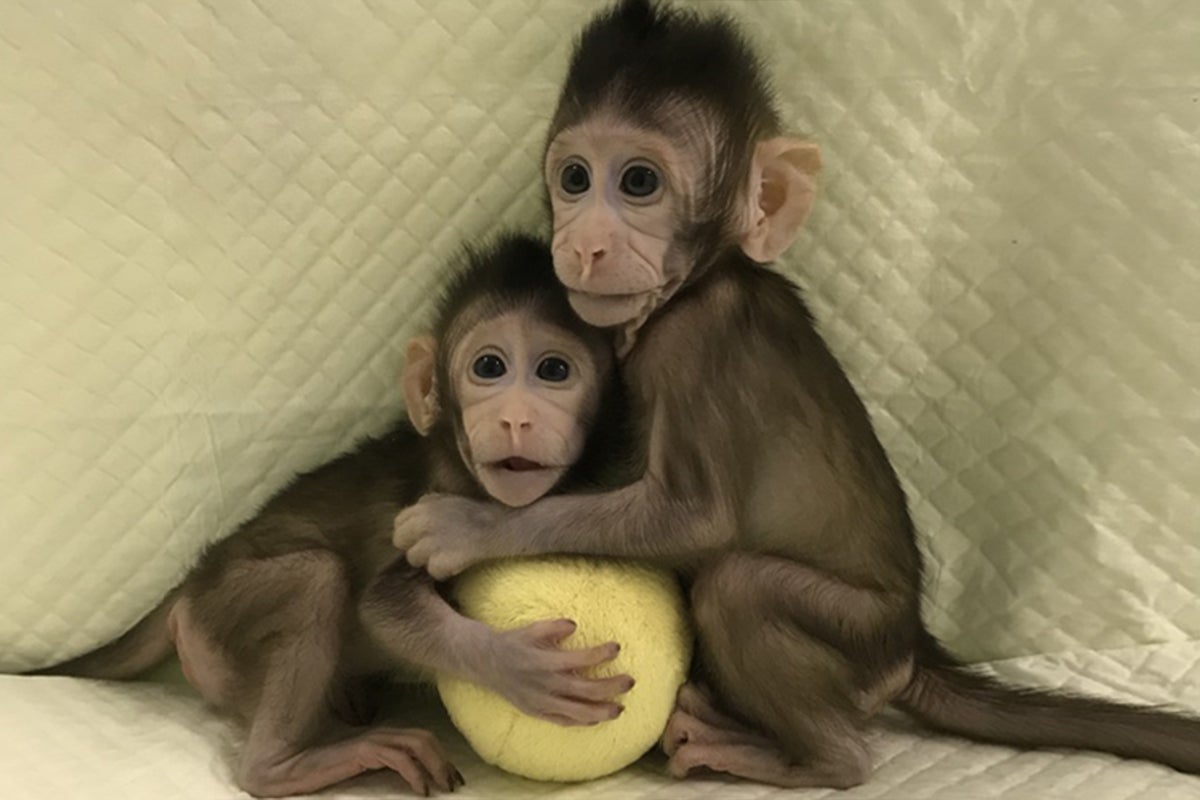Don’t be fooled by the cute photos of the cloned monkeys – they will live a life of pain
The scientists tried 79 times before they got it right. Monkey after monkey was made to live in distressing conditions and then die after a few days. The PR people don’t tell us the names of those babies

The provoking photo of the two cloned monkeys, Zhong Zhong and Hua Hua, says it all. Look at them clinging to each other nervously, their wide eyes both beautiful and haunting. What have these babies seen in the laboratory where they were created? How has it been for them to have the scientists picking and poking at them? Look into their eyes.
The expensive PR machine behind the project has presented news of the first cloned monkeys as a “breakthrough”. It’s like Doctor Frankenstein has turned spin doctor. But what are the bits they’re not telling us?
Whatever you think of the ethics, the practice of animal cloning leads to enormous suffering for animals. Painful, grotesque deformities and early deaths are very much the norm – 96 per cent do not survive beyond six months.

Many cloned animals have faulty or suppressed immune systems and they suffer from a string of health issues including heart failure, respiratory difficulties, and structural disabilities.
The team that created Zhong Zhong and Hua Hua admits there was “much failure before we found a way to successfully clone a monkey”. In fact, they tried 79 times before they got it right. Monkey after monkey was made to live in distressing conditions and then die after a few days. The PR people don’t tell us the names of those babies.
Zhong Zhong and Hua Hua were cloned using the same technique that created Dolly the Sheep in 1996. Dolly was the first time scientists had successfully cloned a mammal from an adult cell, taken from the udder.
Again, scientists were quick to brag about their “success”, and again they weren’t so quick to mention the dark side. Dolly was the sole surviving adult from 277 cloning attempts and she lived a peculiar, stunted life that was plagued from beginning to end by a string of health problems, including premature arthritis. She died of lung cancer.
The awful truth is that Zhong Zhong and Hua Hua will be lucky if they die young, such is the cruelty and suffering that would otherwise be in store for them. The cloning racket is like something from a horror film. Were a random person to do it in their basement, it would be seen as psychotic madness. But behind high walls and under the cover of academic titles and pompously-named laboratories, big bucks allow this “science” a veneer of responsibility.
It says a lot that even when we debate the ethics of animal cloning, most people immediately focus on the prospect of the same process eventually being used on humans. Animals are already suffering – today – but our main worry is that something similar may happen later. Mankind’s exploitative and profiteering relationship with animals – which I regard as a war on animals – is laid bare again.
Non-human primates like the macaques are sensitive, intelligent beings who share many crucial biological and psychological characteristics with us. They are the sort of animals people love and are fascinated by in viral videos and nature documentaries. I think they should be wild and free, swinging happily in their natural habitat.
The late English author and Anglican priest, William Inge, said that humans have “enslaved the rest of the animal creation and treated our distant cousins in fur and feathers so badly that beyond doubt, if they were able to formulate a religion, they would depict the Devil in human form”.
How could anyone disagree? One observer pointed out that Dolly the Sheep looked at humans with “red eyes full of hate”. Zhong Zhong and Hua Hua seem to look at humans with eyes full of fear. Hate and fear – how else would one look upon the Devil?
Join our commenting forum
Join thought-provoking conversations, follow other Independent readers and see their replies
Comments